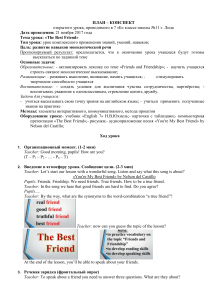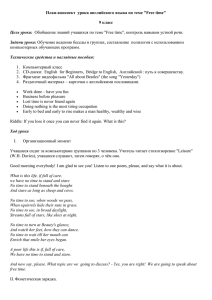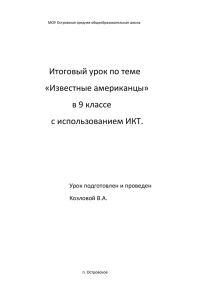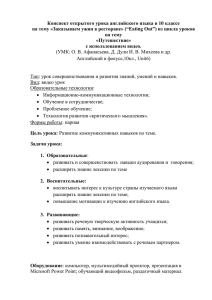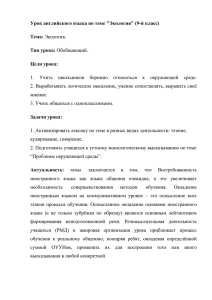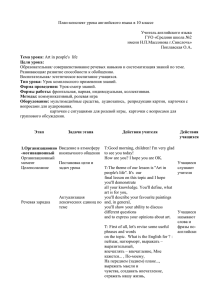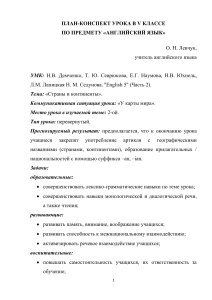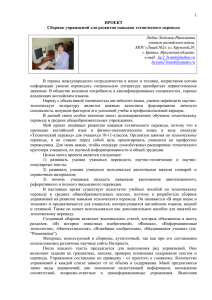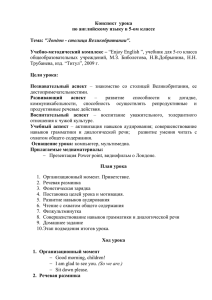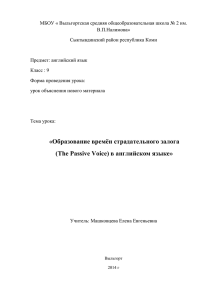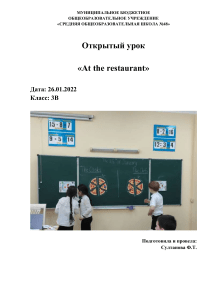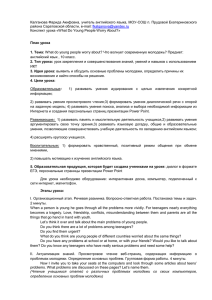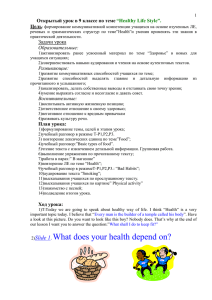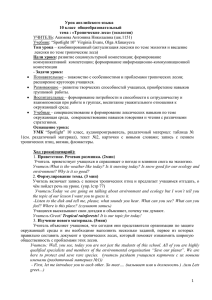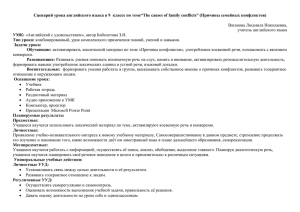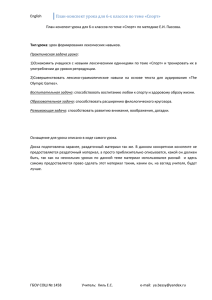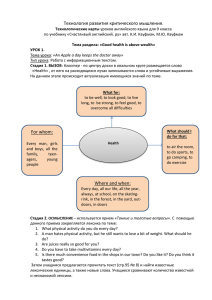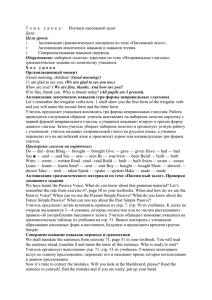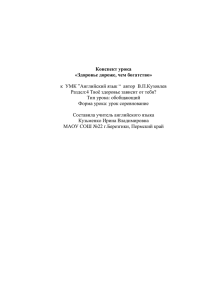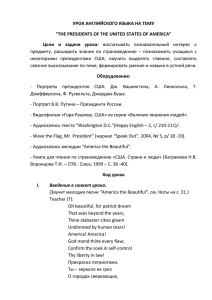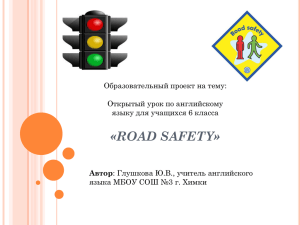Предмет: Литература Великобритании и США Класс: 10 Тема
advertisement
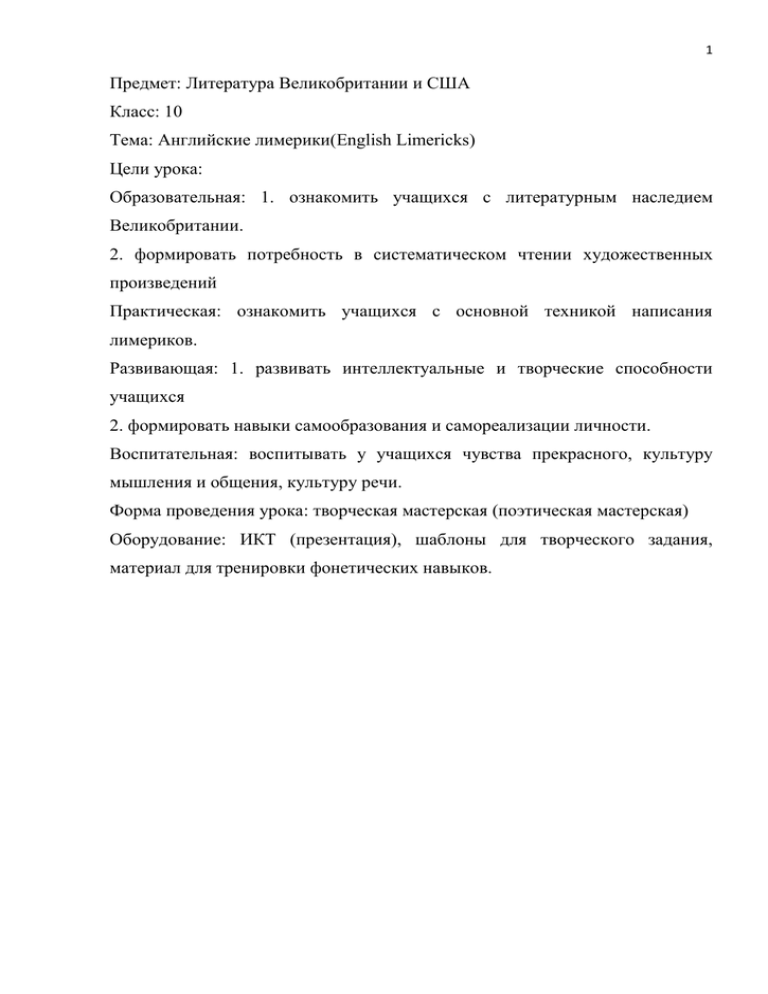
1 Предмет: Литература Великобритании и США Класс: 10 Тема: Английские лимерики(English Limericks) Цели урока: Образовательная: 1. ознакомить учащихся с литературным наследием Великобритании. 2. формировать потребность в систематическом чтении художественных произведений Практическая: ознакомить учащихся с основной техникой написания лимериков. Развивающая: 1. развивать интеллектуальные и творческие способности учащихся 2. формировать навыки самообразования и самореализации личности. Воспитательная: воспитывать у учащихся чувства прекрасного, культуру мышления и общения, культуру речи. Форма проведения урока: творческая мастерская (поэтическая мастерская) Оборудование: ИКТ (презентация), шаблоны для творческого задания, материал для тренировки фонетических навыков. 2 Ход урока Оргмомент. Приветствие. Сообщение темы и целей урока. Вызов интереса учащихся к теме урока. План урока. Основная часть урока. Учитель: Good afternoon dear friends! Today we’re going to speak about a very unusual kind of poetry- the poetry of nonsense. It has been popular all over the world for many centuries. Even now we can meet people who try their hands at composing limericks- small verses that lack any sense but express a true spirit of Old Good England. You will also have an opportunity of composing limericks on your own. At the end of our lesson I suggest your discussing the following problem: Is there any sense in the poetry of nonsense? So, let’s start. To begin with, let’s try and define what a limerick is. (презентация на доске - учитель даёт энциклопедическое определение лимерика, рифмовочной схемы, которые учащиеся записывают в тетради) Учитель: The standard form of a limerick is a stanza of five lines, with the first, second and fifth usually rhyming with one another and having three feet of three syllables each; and the shorter third and fourth lines also rhyming with each other, but having only two feet of three syllables( AABBA). Example: There was a clever old miser who tries Every method to economize. He said with a wink 3 "I save gallons of ink By simply not dotting my i's" The first line traditionally introduces a person and a place, with the place appearing at the end of the first line and establishing the rhyme scheme for the second and fifth lines. In early limericks, the last line was often essentially a repeat of the first line, although this is no longer customary. Exploitation of geographical names, especially exotic ones, is also common, and has been seen as invoking memories of geography lessons in order to subvert the decorum taught in the schoolroom. ( далее, согласно плану урока учащиеся делают мини-доклады с презентациями по темам: “Происхождение названия”, “Эдвард Лир”, “Вариации лимериков”) Учитель: Thank you very much for your work. You’re very knowledgeable about English limericks, the techniques of composing them and now let’s try and discuss the following problem. ( учащиеся высказывают своё мнение, отвечая на вопрос, есть ли смысл в поэзии нонсенса). Учитель: Thank you very much, dear friends. Now, welcome to our Poetry Workshop! (учащиеся читают английские лимерики и собственные переводы) Thank you very much indeed. And now let’s have a go at composing English limericks. I hope the scantling gauges can be very helpful. Let’s try and do it in small groups. ( учащиеся сочиняют лимерики и записывают их в шаблон) Учитель: O.K, your time is up. Are you ready? Please, read out your limericks. Who knows, maybe some day, you will bring out your own “Book of nonsense”. (учащиеся зачитывают свои версии лимериков на английском языке) Учитель: Thank you very much. I’m very pleased with you. You’ve worked properly today. Have you got any necessary information at today’s lesson? Do you think it will come in useful for you in the future? 4 (учащиеся обсуждают, что они узнали на уроке и какова польза данной информации) 3.Окончание урока. 1) Домашнее задание 2) Выставление баллов. Комментарии.
